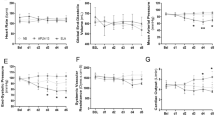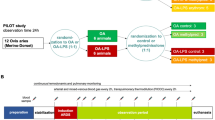Abstract
Background
Apelins are potential candidate therapeutic molecules for hemodynamic support. The objective of this study was to assess the hemodynamic impacts of apelin-13 in a neonatal lamb model of septic shock.
Methods
Lambs were randomized to receive apelin-13 or normal saline. Septic shock was induced by injecting a fecal slurry into the peritoneal cavity. Lambs underwent volume repletion (30 mL/kg over 1 h) followed by intravenous administration of 5 incremental doses (D) of apelin-13 (D1 = 0.039 to D5 = 19.5 µg/kg/h) or normal saline.
Results
Following fecal injection, mean arterial pressure (MAP) and cardiac index (CI) dropped in both groups (p < 0.05). The MAP decreased non-significantly from D1 to D5 (p = 0.12) in the saline group, while increasing significantly (p = 0.02) in the apelin group (−12 (−17; 12) vs. +15 (6; 23) % (p = 0.012)). Systemic vascular resistances were higher in the apelin-13 group at D5 compared to the saline group (4337 (3239, 5144) vs. 2532 (2286, 3966) mmHg/min/mL, respectively, p = 0.046). The CI increased non-significantly in the apelin-13 group.
Conclusion
Apelin-13 increased MAP in a neonatal lamb septic shock model.
Impact
-
Administration of apelin-13 stabilized hemodynamics during the progression of the sepsis induced in this neonatal lamb model.
-
Systemic vascular resistances were higher in the apelin-13 group than in the placebo group. This suggests ontogenic differences in vascular response to apelin-13 and warrants further investigation.
-
This study suggests that apelin-13 could eventually become a candidate for the treatment of neonatal septic shock.
This is a preview of subscription content, access via your institution
Access options
Subscribe to this journal
Receive 14 print issues and online access
$259.00 per year
only $18.50 per issue
Buy this article
- Purchase on Springer Link
- Instant access to full article PDF
Prices may be subject to local taxes which are calculated during checkout


Similar content being viewed by others
Data availability
The datasets generated during and/or analyzed during the current study are available from the corresponding author upon reasonable request.
References
Shane, A. L., Sánchez, P. J. & Stoll, B. J. Neonatal sepsis. Lancet 390, 1770–1780 (2017).
Macarthur, H., Westfall, T. C., Riley, D. P., Misko, T. P. & Salvemini, D. Inactivation of catecholamines by superoxide gives new insights on the pathogenesis of septic shock. Proc. Natl Acad. Sci. USA 97, 9753–9758 (2000).
Andreis, D. T. & Singer, M. Catecholamines for inflammatory shock: a Jekyll-and-Hyde conundrum. Intensive Care Med. 42, 1387–1397 (2016).
Dempsey, E. & Rabe, H. The use of cardiotonic drugs in neonates. Clin. Perinatol. 46, 273–290 (2019).
Weiss, S. L. et al. Surviving sepsis campaign international guidelines for the management of septic shock and sepsis-associated organ dysfunction in children. Intensive Care Med. 46, 10–67 (2020).
Schwarz, C. E. & Dempsey, E. M. Management of neonatal hypotension and shock. Semin. Fetal Neonatal Med. 25, 101121 (2020).
Coquerel, D. et al. Apelin-13 in septic shock: effective in supporting hemodynamics in sheep but compromised by enzymatic breakdown in patients. Sci. Rep. 11, 22770 (2021).
Pan, C. S. et al. Apelin antagonizes myocardial impairment in sepsis. J. Card. Fail. 16, 609–617 (2010).
Maguire, J. J., Kleinz, M. J., Pitkin, S. L. & Davenport, A. P. [Pyr1]Apelin-13 identified as the predominant apelin isoform in the human heart: vasoactive mechanisms and inotropic action in disease. Hypertension 54, 598–604 (2009).
Chapman, N. A., Dupré, D. J. & Rainey, J. K. The apelin receptor: physiology, pathology, cell signalling, and ligand modulation of a peptide-activated class a GPCR. Biochem. Cell Biol. 92, 431–440 (2014).
Boulkeroua, C. et al. Apelin-13 regulates vasopressin-induced aquaporin-2 expression and trafficking in kidney collecting duct cells. Cell. Physiol. Biochem. 53, 687–700 (2019).
Coquerel, D. et al. The apelinergic system as an alternative to catecholamines in low-output septic shock. Crit. Care 22, 10 (2018).
Weiss, J. L., Frederiksen, J. W. & Weisfeldt, M. L. Hemodynamic determinants of the time-course of fall in canine left ventricular pressure. J. Clin. Investig. 58, 751–760 (1976).
Bosse, D. et al. Experimental validation of cardiac index measurement using transpulmonary thermodilution technique in neonatal total liquid ventilation. ASAIO J. 56, 557–562 (2010).
Sage, M. et al. Assessing the impacts of total liquid ventilation on left ventricular diastolic function in a model of neonatal respiratory distress syndrome. PLoS One 13, e0191885 (2018).
Argueta, E. E. & Paniagua, D. Thermodilution cardiac output: a concept over 250 years in the making. Cardiol. Rev. 27, 138–144 (2019).
Rittirsch, D., Huber-Lang, M. S., Flierl, M. A. & Ward, P. A. Immunodesign of experimental sepsis by cecal ligation and puncture. Nat. Protoc. 4, 31–36 (2009).
Rehberg, S. et al. Effects of combined arginine vasopressin and levosimendan on organ function in ovine septic shock. Crit. Care Med. 38, 2016–2023 (2010).
Kato, T. et al. Development and characterization of a novel porcine model of neonatal sepsis. Shock 21, 329–335 (2004).
Wynn, J. L. & Wong, H. R. Pathophysiology and treatment of septic shock in neonates. Clin. Perinatol. 37, 439–479 (2010).
Davis, A. L. et al. American College of Critical Care Medicine clinical practice parameters for hemodynamic support of pediatric and neonatal septic shock. Crit. Care Med. 45, 1061–1093 (2017).
Coquerel, D. et al. Elabela improves cardio-renal outcome in fatal experimental septic shock. Crit. Care Med. 45, e1139–e1148 (2017).
Sahinturk, S., Demirel, S., Ozyener, F. & Isbil, N. [Pyr1]Apelin-13 relaxes the rat thoracic aorta via APJ, NO, AMPK, and potassium channels. Gen. Physiol. Biophys. 40, 427–434 (2021).
Chagnon, F. et al. Apelin compared with dobutamine exerts cardioprotection and extends survival in a rat model of endotoxin-induced myocardial dysfunction. Crit. Care Med. 45, e391–e398 (2017).
Mughal, A., Sun, C. & O’Rourke, S. T. Apelin does not impair coronary artery relaxation mediated by nitric oxide-induced activation of Bk(Ca) channels. Front. Pharmacol. 12, 679005 (2021).
Funding
This study was funded internally (CRC-CHUS, Projets de Recherche Structurants, 2019). It was also supported by the Canadian Institutes of Health Research (CIHR) – Project grants (376770, 389979, and 399567), and the Senior Investigator Award of the Faculty of Medicine (FMSS) (O.L.).
Author information
Authors and Affiliations
Contributions
Conception and design: E.S., D.C., C.N., N.S., J.-P.P., O.L., E.F.-P. Data acquisition: E.S., C.M., D.C., C.N., N.S., E.F.-P. Analysis and interpretation: E.S., D.C., J.P.-P., O.L., E.F.-P. Drafting the article: E.S., E.F.-P. Final approval: E.S., C.M., D.C., C.N., N.S., J.P.-P., O.L., E.F.-P.
Corresponding author
Ethics declarations
Competing interests
The authors declare no competing interests.
Additional information
Publisher’s note Springer Nature remains neutral with regard to jurisdictional claims in published maps and institutional affiliations.
Supplementary information
Rights and permissions
Springer Nature or its licensor (e.g. a society or other partner) holds exclusive rights to this article under a publishing agreement with the author(s) or other rightsholder(s); author self-archiving of the accepted manuscript version of this article is solely governed by the terms of such publishing agreement and applicable law.
About this article
Cite this article
Simard, É., Morin, C., Coquerel, D. et al. Hemodynamic impacts of apelin-13 in a neonatal lamb model of septic peritonitis. Pediatr Res 94, 129–134 (2023). https://doi.org/10.1038/s41390-022-02407-y
Received:
Revised:
Accepted:
Published:
Issue Date:
DOI: https://doi.org/10.1038/s41390-022-02407-y



